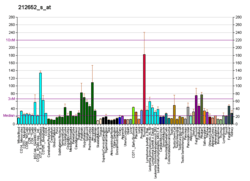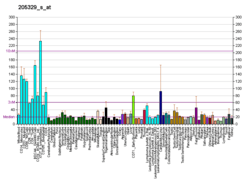SNX4
Sorting nexin-4 is a protein that in humans is encoded by the SNX4 gene.[5][6]
This gene encodes a member of the sorting nexin family. Members of this family contain a phox (PX) domain, which is a phosphoinositide binding domain, and are involved in intracellular trafficking. This protein associated with the long isoform of the leptin receptor and with receptor tyrosine kinases for platelet-derived growth factor, insulin, and epidermal growth factor in cell cultures, but its function is unknown. This protein may form oligomeric complexes with family members.[6]
Interactions
References
- 1 2 3 GRCh38: Ensembl release 89: ENSG00000114520 - Ensembl, May 2017
- 1 2 3 GRCm38: Ensembl release 89: ENSMUSG00000022808 - Ensembl, May 2017
- ↑ "Human PubMed Reference:".
- ↑ "Mouse PubMed Reference:".
- ↑ Haft CR, de la Luz Sierra M, Barr VA, Haft DH, Taylor SI (Dec 1998). "Identification of a family of sorting nexin molecules and characterization of their association with receptors". Mol Cell Biol. 18 (12): 7278–87. doi:10.1128/mcb.18.12.7278. PMC 109309. PMID 9819414.
- 1 2 "Entrez Gene: SNX4 sorting nexin 4".
- ↑ Leprince, Corinne; Le Scolan Erwan; Meunier Brigitte; Fraisier Vincent; Brandon Nathalie; De Gunzburg Jean; Camonis Jacques (May 2003). "Sorting nexin 4 and amphiphysin 2, a new partnership between endocytosis and intracellular trafficking". J. Cell Sci. England. 116 (Pt 10): 1937–48. doi:10.1242/jcs.00403. ISSN 0021-9533. PMID 12668730.
Further reading
- Traer CJ, Rutherford AC, Palmer KJ, et al. (2008). "SNX4 coordinates endosomal sorting of TfnR with dynein-mediated transport into the endocytic recycling compartment". Nat. Cell Biol. 9 (12): 1370–80. doi:10.1038/ncb1656. PMID 17994011.
- Skånland SS, Wälchli S, Utskarpen A, et al. (2007). "Phosphoinositide-regulated retrograde transport of ricin: crosstalk between hVps34 and sorting nexins". Traffic. 8 (3): 297–309. doi:10.1111/j.1600-0854.2006.00527.x. PMID 17319803.
- Rual JF, Venkatesan K, Hao T, et al. (2005). "Towards a proteome-scale map of the human protein-protein interaction network". Nature. 437 (7062): 1173–8. Bibcode:2005Natur.437.1173R. doi:10.1038/nature04209. PMID 16189514.
- Gerhard DS, Wagner L, Feingold EA, et al. (2004). "The status, quality, and expansion of the NIH full-length cDNA project: the Mammalian Gene Collection (MGC)". Genome Res. 14 (10B): 2121–7. doi:10.1101/gr.2596504. PMC 528928. PMID 15489334.
- Ota T, Suzuki Y, Nishikawa T, et al. (2004). "Complete sequencing and characterization of 21,243 full-length human cDNAs". Nat. Genet. 36 (1): 40–5. doi:10.1038/ng1285. PMID 14702039.
- Leprince C, Le Scolan E, Meunier B, et al. (2004). "Sorting nexin 4 and amphiphysin 2, a new partnership between endocytosis and intracellular trafficking". J. Cell Sci. 116 (Pt 10): 1937–48. doi:10.1242/jcs.00403. PMID 12668730.
- Strausberg RL, Feingold EA, Grouse LH, et al. (2003). "Generation and initial analysis of more than 15,000 full-length human and mouse cDNA sequences". Proc. Natl. Acad. Sci. U.S.A. 99 (26): 16899–903. Bibcode:2002PNAS...9916899M. doi:10.1073/pnas.242603899. PMC 139241. PMID 12477932.
- Parks WT, Frank DB, Huff C, et al. (2001). "Sorting nexin 6, a novel SNX, interacts with the transforming growth factor-beta family of receptor serine-threonine kinases". J. Biol. Chem. 276 (22): 19332–9. doi:10.1074/jbc.M100606200. PMID 11279102.
This article is issued from
Wikipedia.
The text is licensed under Creative Commons - Attribution - Sharealike.
Additional terms may apply for the media files.





